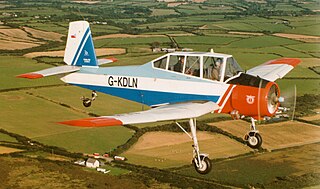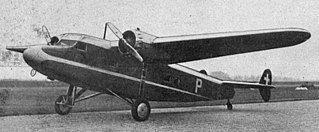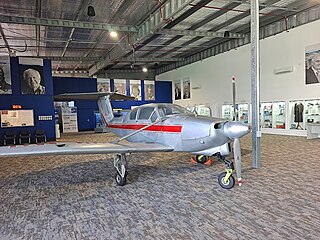
The Aero L-60 Brigadýr was a small, high-wing propeller-driven Czechoslovakian STOL utility aircraft developed for both civil and military use. A prototype, designated XL-60, with Argus As 10C engine, first flew on December 24, 1953, but it was not successful. The plane was thoroughly redesigned and the second improved prototype, with M-208B flat-six engine, flew on June 8, 1954. The aircraft's configuration bears a strong resemblance to the Fieseler Fi 156 "Storch" licence-produced in Czechoslovakia during and after World War II, and which this aircraft was intended to replace. By the end of production in 1960, 273 had been built by Aero, including an improved version, the L-160 with an all-metal tail.

The Fletcher FU-24 is an agricultural aircraft made in New Zealand. Being one of the first aircraft designed for aerial topdressing, the Fletcher has also been used for other aerial applications as a utility aircraft, and for sky diving.

The Auster B8 Agricola was a commercially unsuccessful British agricultural aircraft designed for the aerial topdressing market which opened up in New Zealand in the early 1950s.

The Transavia PL-12 Airtruk is a single-engine agricultural aircraft designed and built by the Transavia Corporation in Australia. The Airtruk is a shoulder-wing strut braced sesquiplane of all-metal construction, with the cockpit mounted above a tractor-location opposed-cylinder air-cooled engine and short pod fuselage with rear door. The engine cowling, rear fuselage and top decking are of fibreglass. It has a tricycle undercarriage, the main units of which are carried on the lower sesquiplane wings. It has twin tail booms with two unconnected tails. Its first flight was on 22 April 1965, and was certified on 10 February 1966.

The PZL-101 Gawron (rook) is a Polish agricultural and utility aircraft designed and built by WSK-Okęcie.

The Air Tractor AT-300 is a family of agricultural aircraft that first flew in the United States on September 1973. Type certification was awarded to Air Tractor in November the same year, and serial production commenced in 1976. Of low-wing monoplane taildragger configuration, they carry a chemical hopper between the engine firewall and the cockpit.

The Zlin Z-37 Čmelák, also known as LET Z-37 Čmelák is an agricultural aircraft which was manufactured in Czechoslovakia. It is powered by a Soviet-built Ivchenko reciprocating engine. The aircraft is used mainly as a cropduster.

The PZL-106 Kruk is a Polish agricultural aircraft designed and built by WSK PZL Warszawa-Okęcie.

The Commonwealth Aircraft CA-28 Ceres was a crop-duster aircraft manufactured in Australia by the Commonwealth Aircraft Corporation (CAC) between 1959 and 1963. The aircraft was a development of the Wirraway trainer of World War II.

The Yeoman Cropmaster was an Australian agricultural aircraft developed from the CAC Wackett trainer of World War II.
The Civil Aviation Department Revathi was a light utility aircraft designed in India principally for use by that country's flying clubs.

The Junkers Ju 46 was a German shipborne catapult-launched seaplane derivative of the W 34, constructed for pre-war Luft Hansa's mail service over the Atlantic Ocean. The first production models were delivered in 1932 and replaced the Heinkel He 58, which, along with the He 12, had pioneered these ship-to-shore mail delivery flights.

The Koolhoven F.K.50 was a 1930s Dutch eight-passenger light transport monoplane designed and built by Koolhoven.
The SIAI-Marchetti SM.101 was a 1940s Italian single-engined light transport cabin monoplane designed and built by SIAI-Marchetti.
The Saro A.33 was a British prototype flying boat built by Saunders-Roe Limited in response to a British Air Ministry Specification R.2/33 and in competition with the Short Sunderland.

The Mosscraft MA.1 was a British light two-seat low-winged sporting monoplane of the 1930s.
The Redfern Nieuport 17/24 is an American homebuilt aircraft that was designed by Walter Redfern and produced by the Walter Redfern Company of Post Falls, Idaho, based upon the First World War Nieuport 17 and Nieuport 24 fighter aircraft. When it was available the aircraft was supplied in the form of plans for amateur construction.
The Kalinin K-6 was a mail-plane designed by Konstantin Alekseevič Kalinin. It was an aircraft largely derived from the previous Kalinin K-5, which shared its wing, tail and landing gear. This aircraft differed from the previous one by the new fuselage design, which was slender and had a four-meter compartment for the load. The K-6 flew for the first time in 1930 but remained at the prototype stage, since mass production was never authorised.

The Victa R-2 was a prototype Australian single-engine four-seat light aircraft built by Victa Ltd in the early 1960s. A single example was built, first flying in February 1961, but no production followed.
The Ultra-Efficient Products Penetrater is an American ultralight aircraft designed by Nick Leighty and Rick Berstling and produced by Ultra-Efficient Products. It was first shown at the 1985 Sun 'n Fun air show.















